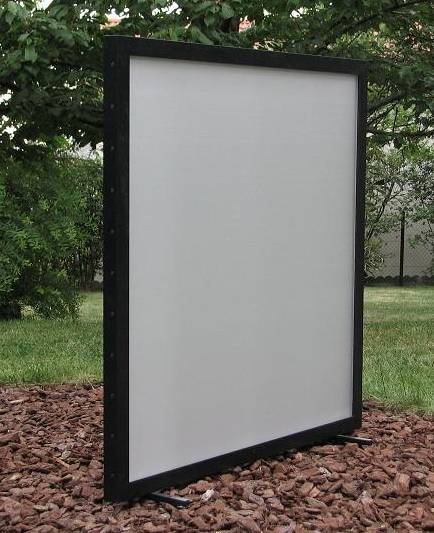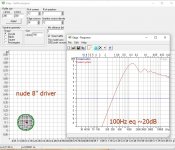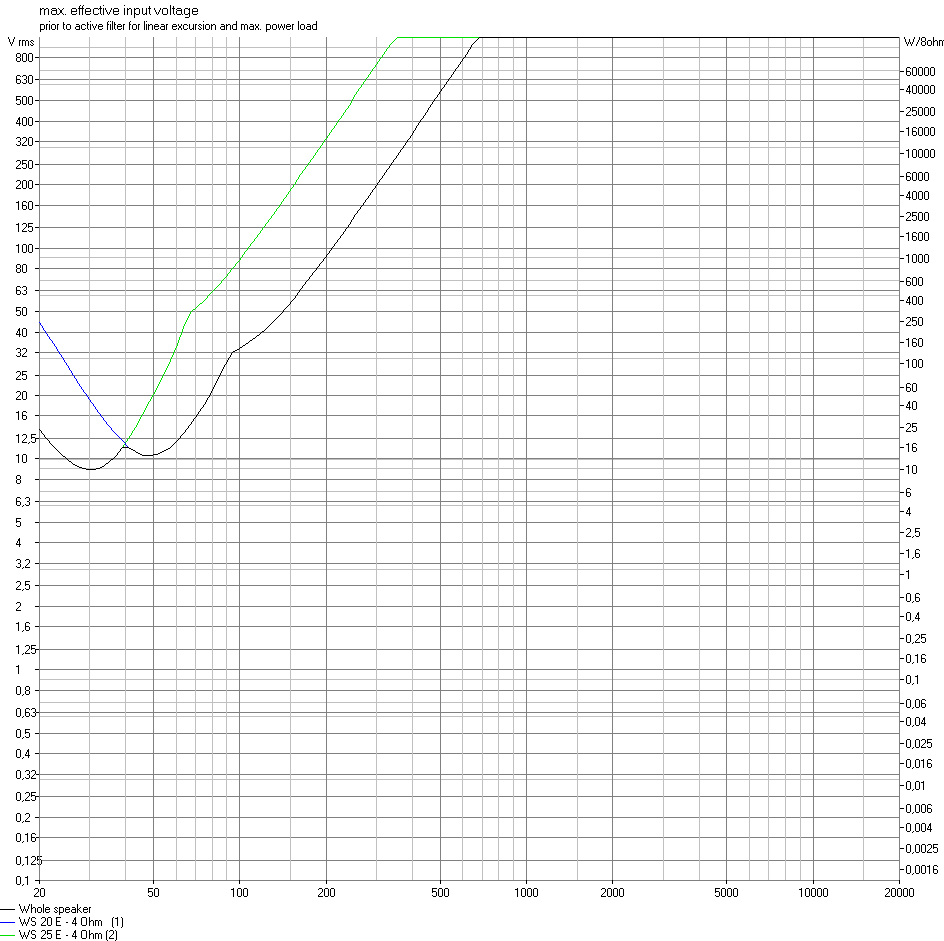Hello gentlemans,
Could you give me the maximal linear excursion that i can expext fom a Visaton WS20E4 driver at 50Hz in a open baffle please ?
WS 20 E - 4 Ohm
Could you give me the maximal linear excursion that i can expext fom a Visaton WS20E4 driver at 50Hz in a open baffle please ?
WS 20 E - 4 Ohm
For +/- 6mm max you might have +/- 2-3mm of linear range?
Well linear and linear... Here is SB 6,5" for example http://medleysmusings.com/sb17nrxc35-4/
Well linear and linear... Here is SB 6,5" for example http://medleysmusings.com/sb17nrxc35-4/
An externally hosted image should be here but it was not working when we last tested it.
Hi,
Excursion is specified as +/- 6mm. However in an open
baffle the effective excursion is much less, how much
less depends on the size of the baffle and baffle loss.
There will be a number for 50Hz, think very low.
rgds, sreten.
Excursion is specified as +/- 6mm. However in an open
baffle the effective excursion is much less, how much
less depends on the size of the baffle and baffle loss.
There will be a number for 50Hz, think very low.
rgds, sreten.
For +/- 6mm max you might have +/- 2-3mm of linear range?
Well linear and linear... Here is SB 6,5" for example http://medleysmusings.com/sb17nrxc35-4/
Thx, very interesting.
Visaton datasheet is a little bit wrong, the height of front pole-plate is 5 mm and the height of winding is 11 mm, i should expect 6mm of travel.
-+3mm before the total lost of control.
Hi,
Excursion is specified as +/- 6mm. However in an open
baffle the effective excursion is much less, how much
less depends on the size of the baffle and baffle loss.
There will be a number for 50Hz, think very low.
rgds, sreten.
"the effective excursion is much less"
Why, could you explain a little bit more please ?
Last edited:
PS : i dont use any baffle and only under 100Hz.
PS2 : Ok, it is impossible to know... THX for your answers.
PS2 : Ok, it is impossible to know... THX for your answers.
Last edited:
The excursion with a given amount of input power will be the same regardless of it being in a box, open baffle or naked.
However due to the acoustic short circuit in open baffle or naked the sound pressure level at a couple of meters distance will be much lower than if the driver were in a box.
When the short circuit kicks in depends on the baffle dimensions but the lower the frequency the more efficient the short is and the lower the volume produced by the driver.
However due to the acoustic short circuit in open baffle or naked the sound pressure level at a couple of meters distance will be much lower than if the driver were in a box.
When the short circuit kicks in depends on the baffle dimensions but the lower the frequency the more efficient the short is and the lower the volume produced by the driver.
The excursion with a given amount of input power will be the same regardless of it being in a box, open baffle or naked.
However due to the acoustic short circuit in open baffle or naked the sound pressure level at a couple of meters distance will be much lower than if the driver were in a box.
When the short circuit kicks in depends on the baffle dimensions but the lower the frequency the more efficient the short is and the lower the volume produced by the driver.
Thanks for your clarification and i really need to clarify... too.
My exact question is :
"How much power my loudspeaker is able to handle without going out of its magnetic gap"
Last edited:
The excursion with a given amount of input power will be the same regardless of it being in a box, open baffle or naked.
That's not correct, that's only true if you are applying DC current over a period of time. The excursion depends on the radiation resistance at the specific frequency. If the membrane got a high 'load' the excursion depends (besides the suspension of the driver) on the air spring stiffness, air mass to be moved, influence of the enviroment (with only a baffle or without anyhting you can't really call it a 'box') which also includes the change of Qt, fb etc.. So no, with less resistance of the movement the excursion will be higher with the same force or the other way around, you'll reach the maximum linear excursion with smaller forces. Best example (let's just look at sealed enclosures): Vary the volume of a sealed enclosure and you get different frequency responses. Since in a closed box surface x excursion still applies, you'll have to apply different forces (power) to get the same frequency response or in other words, you have to modify the force at the same frequency to get the same spl.
Hi,
Driver excursion on an open baffle is very near what it would
be open air or in a very large sealed box. That determines
the effective power handling, but not the SPL produced.
Whilst for sealed excursion times cone area = a given SPL,
for open baffles its not true, due to the baffle loss, which
gets worse the smaller the effective baffle size is.
A good primer is :
http://www.quarter-wave.com/OBs/OB_Design_Part_1.pdf
http://www.quarter-wave.com/OBs/OB_Design_Part_2.pdf
Note that maximum bass SPL is much lower than you'd expect,
and is why big bass drivers are a good idea for open baffles.
rgds, sreten.
Driver excursion on an open baffle is very near what it would
be open air or in a very large sealed box. That determines
the effective power handling, but not the SPL produced.
Whilst for sealed excursion times cone area = a given SPL,
for open baffles its not true, due to the baffle loss, which
gets worse the smaller the effective baffle size is.
A good primer is :
http://www.quarter-wave.com/OBs/OB_Design_Part_1.pdf
http://www.quarter-wave.com/OBs/OB_Design_Part_2.pdf
Note that maximum bass SPL is much lower than you'd expect,
and is why big bass drivers are a good idea for open baffles.
rgds, sreten.
Last edited:
silverprout, you are asking too much from a 8" woofer.
With the needed equalization, it simply can't handle bass even at 100Hz . Usually dipole bass is 2 10-12" subwoofer drivers. I have a nude 12" and it needs almost 20dB of eq to reach 100Hz! This is so crazy that it is hard to believe, but trust me!
Check John Kreskowsky's studies NaO Note II RS Details
With the needed equalization, it simply can't handle bass even at 100Hz . Usually dipole bass is 2 10-12" subwoofer drivers. I have a nude 12" and it needs almost 20dB of eq to reach 100Hz! This is so crazy that it is hard to believe, but trust me!
Check John Kreskowsky's studies NaO Note II RS Details
Attachments
Last edited:
That's not correct, that's only true if you are applying DC current over a period of time. The excursion depends on the radiation resistance at the specific frequency. If the membrane got a high 'load' the excursion depends (besides the suspension of the driver) on the air spring stiffness, air mass to be moved, influence of the enviroment (with only a baffle or without anyhting you can't really call it a 'box') which also includes the change of Qt, fb etc.. So no, with less resistance of the movement the excursion will be higher with the same force or the other way around, you'll reach the maximum linear excursion with smaller forces. Best example (let's just look at sealed enclosures): Vary the volume of a sealed enclosure and you get different frequency responses. Since in a closed box surface x excursion still applies, you'll have to apply different forces (power) to get the same frequency response or in other words, you have to modify the force at the same frequency to get the same spl.
Hi,
Driver excursion on an open baffle is very near what it would
be open air or in a very large sealed box. That determines
the effective power handling, but not the SPL produced.
Whilst for sealed excursion times cone area = a given SPL,
for open baffles its not true, due to the baffle loss, which
gets worse the smaller the effective baffle size is.
A good primer is :
http://www.quarter-wave.com/OBs/OB_Design_Part_1.pdf
http://www.quarter-wave.com/OBs/OB_Design_Part_2.pdf
Note that maximum bass SPL is much lower than you'd expect,
and is why big bass drivers are a good idea for open baffles.
rgds, sreten.
silverprout, you are asking too much from a 8" woofer.
With the needed equalization, it simply can't handle bass even at 100Hz . Usually dipole bass is 2 10-12" subwoofer drivers. I have a nude 12" and it needs almost 20dB of eq to reach 100Hz! This is so crazy that it is hard to believe, but trust me!
Check John Kreskowsky's studies NaO Note II RS Details
Thanks for your clever answers.
I love to explain things without using my technical knowledge, I found it utterly fun (please don't be shocked), so there are some common points between gas and liquids i will use air and water.
This is what I understand:
ICG
When you jump from the diving, your pain is proportional to the speed when you arrive at the water contact, water is like concrete at high speed, you are right for me.
Sreten
Big rocks are much better than small ones to make waves on the water surface, you are not totally right IMHO.
Juhazi
Please read below, sorry if it's boring.
When you swim with swim fins you make large and slow amplitude movements in order to manage your muscular energy.
But when you want to increase your speed the water resistance requires so much energy that you naturally reduce the amplitude of your movements.
Because you can’t maintain force and increase the speed at the same time without a tremendous muscular power.
The air seem easier to move but a large membrane offer a large surface of contact with air, the same driver in an open baffle offers (60-80%) more surface in contact with the air.
At low frequency, it is like big swim fins in water, the energy of actuation is proportional to the membrane in contact wit the air... and the motor of the transducer must be able to control dynamically this membrane without deform it.
A very strong motor AND a large membrane are required to beat the air “resistance” and the membrane must be strong enough to assume the energy transfer without undesirable deformations.
Big and rigid is heavy, a light membrane will never be able to actuate the air properly in a OB application.
IMHO, the only way to move air at low frequencies with a light membrane is to control it on its entire surface to avoid uncontrolled deformations… there is only one loudspeaker on the planet that can do this miracle, and the motor weight 50Kg.
The Infraplanar.

I use the Visaton cheap loudpeaker for my proximity dipole (50Hz-100Hz) listenings, because the OB radiation profile of this transducer gives me a good bass response down to 40Hz@-6dB with my head at 0,5m of distance.
There is no bass at all at 1m, I don’t excite the room resonances at all and don’t disturb the people living in the nearest rooms.
I was expecting around 70dB@ 0,5 meters of the direct membrane radiation.
IRL I have 60dB at the listening position but with huge membranes excursions (probably out of the magnetic gap).
I want to apply a 24dB LR active filter at 50, 60, 70 or 80Hz in order to stay in the magnetic gap and avoid odd sound glitches.
Last edited:
my 2x10" naked give 75db to 2m around 5% distortion so i believe 70db on 50cm is quite true on stereo 8"
T
Sreten
Big rocks are much better than small ones to make waves on the water surface, you are not totally right IMHO.
Hi, I can assure you my assertions are totally right, rgds, sreten.
Only by misunderstanding reality would you want to disagree.
Hi,
That graph isn't telling you anything useful, just boring maths.
rgds, sreten.
I 'm hammering my nail 😉
It help me to decide something, soothsayers are expensive and boxsim is free.
Simulated in a infinite baffle (10000liters
 ) with 12dB octave active crossovers.
) with 12dB octave active crossovers.Now i have the illusion that the coils will stay in the magnetic gap if i d'ont exceed 10W and my brain gives me my endorphin

- Status
- Not open for further replies.
- Home
- Loudspeakers
- Multi-Way
- WS20E4 max excursion in a open baffle design


